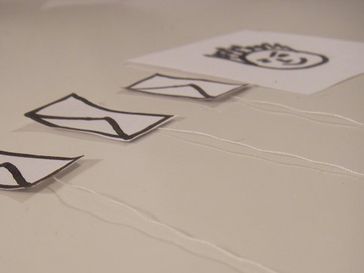Since our first couple of videos came out, I've been talking to a lot of people about what makes the Paperworks format work. Aside from the content/message, I often say that a set of constraints is what makes the format a great fit for our goals.
In this case, a "constraint" is a rule that we have decided not to break in making our videos.
Examples: We only use certain materials (paper, whiteboard, markers, string), we won't make a video over 4 minutes long, we only use our hands to tell the story and we don't use any external music (just humming, snaps, claps, etc.). Further, everything we make in the format is 100% copyright infringement free. These are the Paperworks constraints and they have a huge impact.

You might think that having constraints is limiting, but I think the opposite. Constraints are liberating. By narrowing the scope of possibilities down to only a few ways to present ideas, we can eliminate needless decision making and complexity.
Consider these examples:
Materials: By limiting ourselves to paper, markers and a whiteboard, we don't have to think about all the things we *could* do with flash animation, 3D, focus, perspective and the like. Our materials, while limited, keep us lightweight and simple.
Time: By limiting the video's possible length to 4 minutes, we limit ourselves to major points. We don't sweat the small stuff.
Hands: By using only our hands, we don't have to think about clothes, hair, make-up or even facial expressions.
Music: By not using external music, we don't have to pick the right song or worry about being sued.
The Lesson: The lesson is that constraints work to limit the number and depth of decisions we have to make. By eliminating the decisions about technology, presentation, music, etc. we have time to focus on the core of what makes Paperworks work: the ideas.
The essence of the Paperworks format is simplicity - bringing down the bar of technology and presentation to it's most basic level. By doing away with fancy graphic and soundtrack options, we can make room to think more deeply about the idea and concept that will convey the message in the simplest way we can. Further, it's a format almost everyone can use - it's not limited by complex technologies.
A Bit of Inspiration: If you haven't read The Paradox of Choice by Barry Schwartz, I recommend picking it up. It made me think about the hidden dangers of having too many options. Another inspiring book is Made To Stick by Chip and Dan Heath, which I reviewed briefly here.